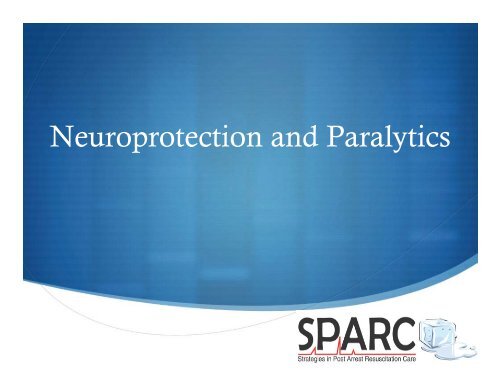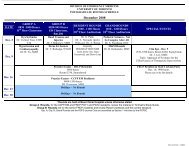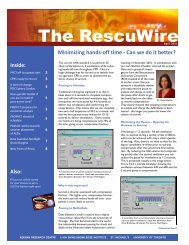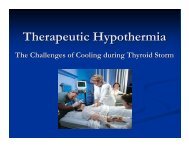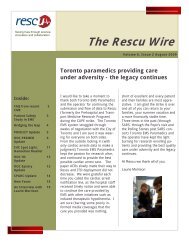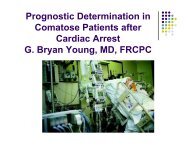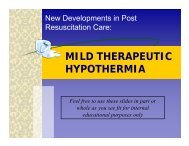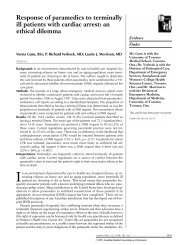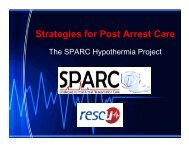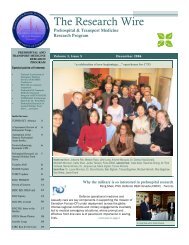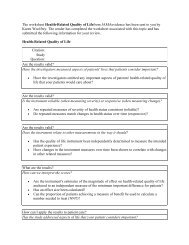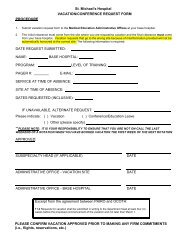Neuroprotection and Paralytics Presentation - Emergency Medicine
Neuroprotection and Paralytics Presentation - Emergency Medicine
Neuroprotection and Paralytics Presentation - Emergency Medicine
- No tags were found...
Create successful ePaper yourself
Turn your PDF publications into a flip-book with our unique Google optimized e-Paper software.
<strong>Neuroprotection</strong> <strong>and</strong> <strong>Paralytics</strong>
ObjectivesReview the importance of hypothermia forneuroprotection after cardiac arrestDiscuss PROS <strong>and</strong> CONS of usingneuromuscular blockers to facilitatecoolingDiscuss a practical approach
Post-Resuscitation CareOnly 10% of cardiac arrests that arrive athospital alive survive to go home !About 60% of cardiac arrest survivorsregain consciousness1/3 experience irreversible cognitivedisabilities
Improving NeurologicalOutcomes High temperatures after an arrest lead to poorerneurological recovery Therapeutic hypothermia has been shown toimprove neurological outcome
Mild Therapeutic HypothermiaThe goal of therapy =initiate within 2-4 hours of return of spontaneouscirculationtarget core temperature of 32-34°C reached within 6hours after initiation of treatment. Theory is based in its ability to prevent the cascade ofevents following a cardiac arrest which inhibit neurologicfunctioning
How It Is Thought to WorkSeveral mechanisms:Reduces cerebral metabolic rateSuppresses free radical productionSuppresses excitatory amino acidreleaseSuppresses calcium shifts
Clinical Evidence
Prospective RCT 77 adults post VF arrest, with coma Cooled patients to 33C by 2h post ROSC started with ice packs placed by EMS maintained temp for 12h
Neurological Outcome& Survival at 6 months Survival to good outcome – 49% hypothermiavs 26% control (p-0.046) Odds ratio for good outcome withhypothermia: 5.25 (95 percent CI 1.47 to 18.76; P=0.011)Bernard et al. NEJM 2002
Prospective RCT, multicentre 275 adult patients were cooled to 32-34C Goal to achieve temp = 4h (actual result8h) Cooling blanket plus ice packs Hypothermia maintained for 24h
Neurological Outcome &Survival at 6 monthsP=0.009P=0.02RR=1.40RR=0.74HACA NEJM 2002, 346:549
How was it done in the studies?Bernard et alHACA trial All patients given midazolam (2to 5 mg) <strong>and</strong> vecuronium (8 to 12mg)Doses adjusted as neededWhen core temperature < 33°C,ice packs removed <strong>and</strong>temperature maintained for 12hours while patient continuedwith sedation <strong>and</strong> paralysis withsmall doses of midazolam <strong>and</strong>vecuronium, as required toprevent shiveringSedation induced by IVmidazolam (0.125 mg per kg perhour) <strong>and</strong> fentanyl (0.002 mg perkg per hour) Doses adjusted as needed for 32hoursTo prevent shivering, paralysisinduced by IV pancuronium (0.1mg per kg) q2h for 32 hours
What happens when we cool? Leads to activation of counter-regulatorysystems: Increased sympathetic tone Vasoconstriction of vessels under skin(~36.5° C) Reduction of heat loss up to 25% Heat production by SHIVERING (~35.5° C)
What’s wrong with shivering? Increases metabolic rate Increases oxygen consumption 40-100% in awake patients Excess work of breathingLinked toadverse cardiacevents Increased heart rate General stress like response Impedes / slows cooling!
Caveats… Increased adverse cardiac events are linked tohemodynamic <strong>and</strong> respiratory consequences <strong>and</strong>responses, rather than to shivering per se Hemodynamic <strong>and</strong> respiratory responses are much lesspronounced in SEDATED patients: Heart rate typically DECREASES in SEDATEDpatients Increased work of breathing less of a concern inmechanically ventilated patients
Beneficial Effects of NMBs Highly effective at obliterating shivering response Do not cause hypotension (unlike most sedatingagents) Important advantage in hemodynamically-unstablepatients Can lead to more rapid cooling if used appropriately(<strong>and</strong> if shivering response is marked)
Detrimental Effects of NMBs Masks insufficient sedation! Awake but paralyzed can have profound psychologicaldownstream effects (PTSD) Awake/aware patients will have increased stress responseCan mask seizure activitySeizures are frequent after anoxic brain injurySeizures increase cerebral metabolic dem<strong>and</strong>s, may worsenneurological outcomesIf continuous NMBs used, strongly consider continuous EEGProlonged paralysis has been linked to critical illnesspolyneuropathy
Detrimental Effects of NMBs Masks insufficient sedation! Awake but paralyzed can have profound psychologicaldownstream effects (PTSD) Awake/aware patients will have increased stress response Can mask seizure activity Seizures are frequent after anoxic brain injury Seizures increase cerebral metabolic dem<strong>and</strong>s, may worsenneurological outcomes If continuous NMBs used, strongly consider continuous EEG Prolonged paralysis has been linked to critical illnesspolyneuropathy
Alternatives to NMBs Recent experience suggests most patients can beadequately <strong>and</strong> effectively cooled with sedatives <strong>and</strong>analgesics alone Sedatives <strong>and</strong> analgesics have advantage of causingvasodilation, increasing transfer of heat from the coreto the periphery (leading to more rapid cooling) Avoids complications associated with NMBs Shivering response is diminished (<strong>and</strong> sometimesabsent) at temperatures less than 33.5° C
Suggested Approach Start cooling with infusions of sedatingmedications (i.e. benzodiazepines +/-propafol) <strong>and</strong> analgesics (i.e. narcotics) Use intravenous magnesium
Suggested Approach Use boluses of neuromuscular blockers as needed ifany of the following occurs: Agitation <strong>and</strong> shivering continues despite aggressivesuppression with sedation/analgesia Temperature not dropping If unable to reach target temperature for cooling after 4hours Use infusions of neuromuscular blockers only ifpatient is refractory to attempts to induce hypothermia
Comparing Efficacy of Anti-Shivering ApproachesMagnesium ++Propafol +++Benzodiazepines ++Meperidine ++++Fentanyl +++Morphine +++Clonidine +++NMBs +++++`
Shivering Scale
Choice of NMB
•TherapeuticHypothermiaSCCM Guidelines
•TherapeuticHypothermia
Suggested Choices First line: Pancuronium Initial dose: 0.1 mg/kg Bolus doses: 0.5 to 2mg IV prn Infusion dose: 1-2 g/kg/min Second line: (Hepatic or renal dysfunction, orcontraindication to vagolytic drug) Cisatracurium Initial dose: 0.2 mg/kg Bolus doses: 0.1 mg/kg Infusion dose: 2 to 3 g/kg/min (~0.1 to 0.2mg/kg/h) Atracurium Initial dose: 0.4 to 0.5 mg/kg Infusion dose: 4-10 g/kg/min
•Plasma concentration of NMBs declinemore slowly with hypothermia•Duration of effect of NMBs are prolongedwith hypothermia
Precautions while using NMBs Do not reduce or discontinue narcotics /benzodiazepines / propafol while paralyzed Ensure adequate sedation/analgesia Patients should receive eye protection whileparalyzed Eye lube to each eye tid <strong>and</strong> prn OR natural tears 0.5% 2 drops each eye q6h <strong>and</strong> prn Monitor renal <strong>and</strong> hepatic function to ensureoptimal selection of NMB
Precautions while using NMBs Consider monitoring train-of-four when using infusions Aim for 2/4 Inability to monitor train-of-four should not preventuse of NMBs If using continuous infusions of NMB, consider dailyEEG or continuous EEG if available To monitor for non-convulsive status epilepticus Consider discontinuing NMB once core temperature
Conclusions Shivering is a common physiological response totherapeutic hypothermia Shivering can usually be controlled/prevented withuse of deep sedation <strong>and</strong> narcotics, Mg infusion NMBs can be a useful tool to obliterate shivering,but should be reserved as a second-line agent (aftersedation/narcotics, Mg infusion) First try boluses as-needed If NMB infusions required ensure adequate sedation


